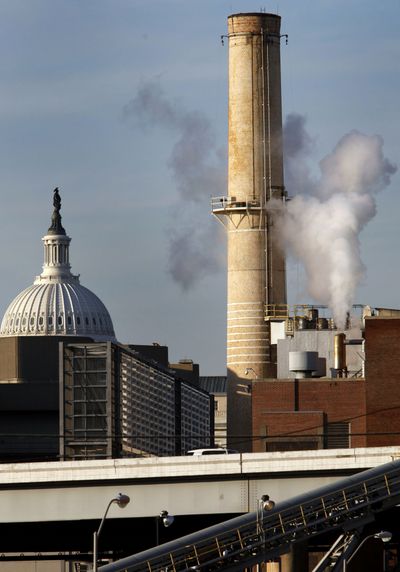D.C. runs low on green power
Lawmakers’ options for facility narrow

WASHINGTON – As Congress tries to clean up the nation’s energy sources and cut gases blamed for global warming, it is struggling to do so in its own backyard.
The Capitol Power Plant, a 99-year-old facility that heats and cools the hallowed halls of Congress, still burns coal and accounts for one-third of the legislative branch’s greenhouse gas emissions. For a decade, lawmakers have attempted to clean it up.
In recent years, Congress has reduced its energy consumption. The steam and chilled-water power plant has become more efficient. It now burns more natural gas and only 35 percent coal, compared with 49 percent in 2007.
But Congress is running out of options to make the plant fully green. On Friday the House announced that it was abandoning its goal to be carbon neutral and would no longer buy offsets to make sure it was removing as much carbon dioxide from the atmosphere as it releases. Those offsets were key to zeroing out the remaining emissions at the power plant that could not be reduced by other means.
The issues hampering the cleanup – politics, cost and technological barriers – could trip up similar efforts elsewhere. The U.S. counts on coal-fired power plants for about half of its electricity; the plants are also the biggest source of heat-trapping gases.
In 2007, the facility released 118,851 tons of carbon dioxide, according to the Energy Department. That’s a fraction of the amount released by the roughly 600 coal-fired power plants nationwide that produce electricity, and the emissions created at other plants from which Congress buys power.
“We are holding it up as a symbol for how we can and must do better,” said Mike Tidwell, director of the Chesapeake Climate Action Network.
While carbon dioxide from the facility could be reduced 60 percent using carbon sequestration technology, the Energy Department in April 2008 ruled that out. The $112 million cost was too high. There is no place nearby to dispose of the gas and the extra coal burned to run the carbon-trapping equipment would increase other types of air pollution.
Offsetting the power plant’s emissions by investing in projects that reduce carbon elsewhere also doesn’t look like a viable option. The House spent $89,000 in 2007 and 2008 in part to cancel out the remaining portion of its carbon dioxide emissions at the plant. But on Friday the House said it would no longer purchase offsets because there is no way to verify whether the investment actually results in carbon neutrality.
Recognizing these dead ends, just last week House Speaker Nancy Pelosi, D-Calif., and Senate Majority Leader Harry Reid, D-Nev., wrote the Architect of the Capitol, which oversees the maintenance and operation of the Capitol Complex, including the Capitol Power Plant, with another recycled idea: Convert the plant entirely to natural gas.
While four times more expensive than coal, natural gas produces about half as much carbon dioxide.
Referring to the facility as a shadow hanging over efforts to make Congress more environmentally friendly, Pelosi and Reid said the conversion would demonstrate Congress’ willingness to deal with global warming, energy independence and the use of finite fossil fuels.
Converting the plant entirely to natural gas would require equipment upgrades at the facility that would cost between $6 million and $7 million, in addition to having to buy more natural gas. It would cost $139 per ton of carbon dioxide saved, or about $2 million a year just for the House’s portion of heating and air conditioning.